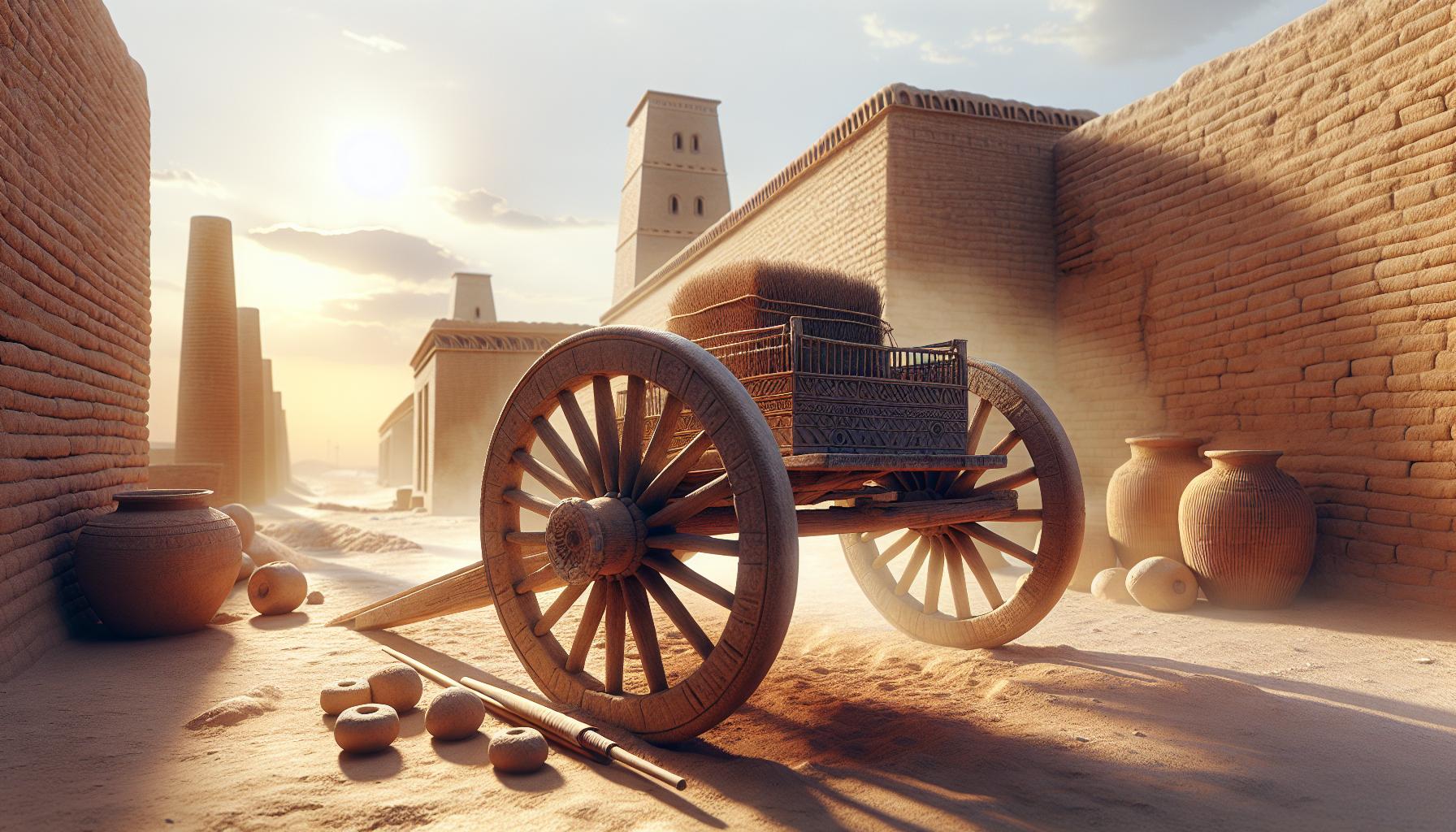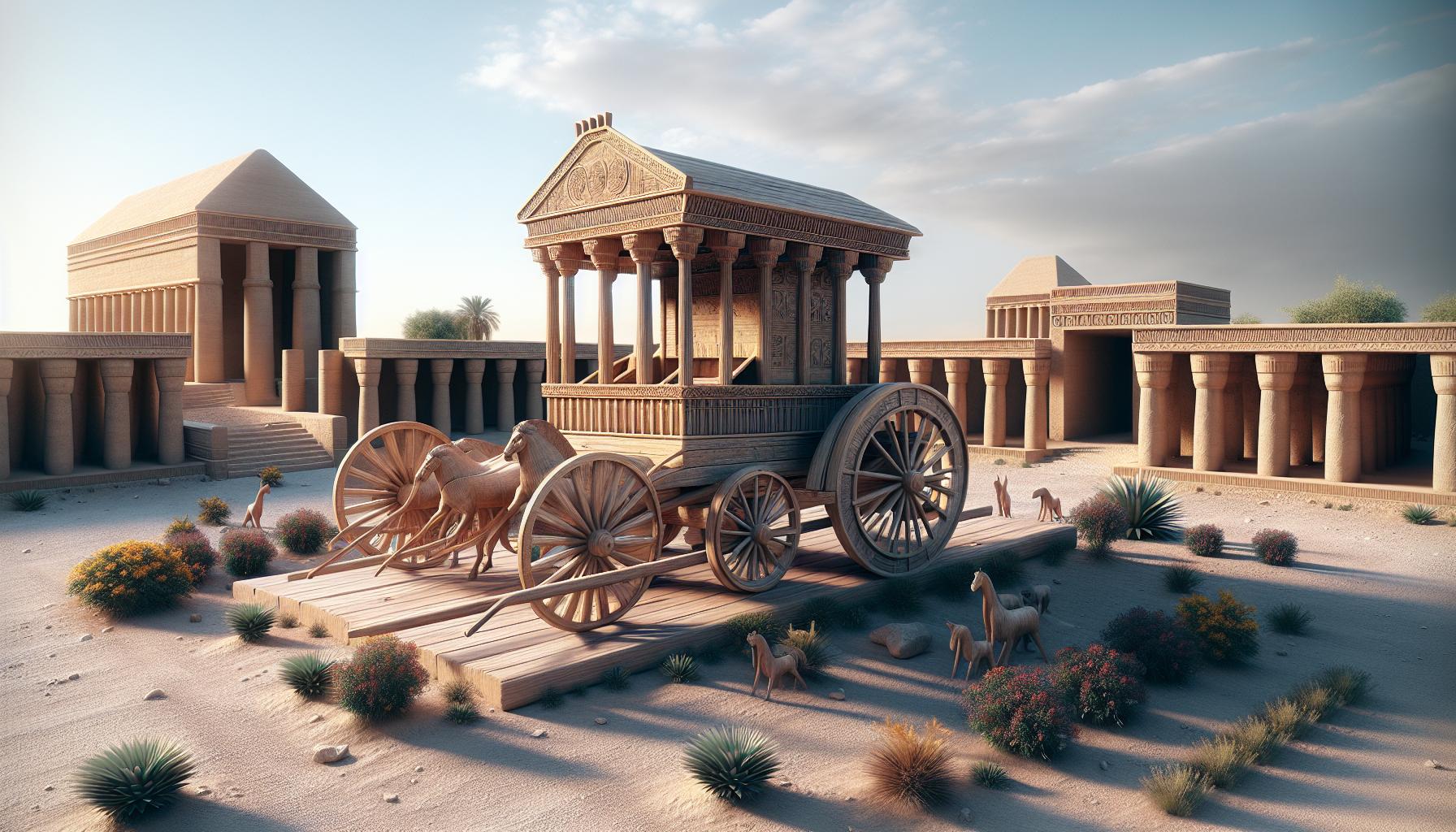Have you ever wondered about the origins of one of the most revolutionary inventions in human history? The Mesopotamian wheel development marks a pivotal moment that transformed transportation and agriculture. Imagine a world without the wheel – it’s hard to picture, isn’t it?
In ancient Mesopotamia, the birthplace of the wheel, innovation and progress intersected to create a technology that would stand the test of time. The wheel’s evolution from a simple potter’s tool to a crucial element in chariots and carts revolutionized trade, communication, and the way societies operated.
As you delve into the fascinating journey of Mesopotamian wheel development, you’ll uncover the ingenuity and vision of ancient civilizations that laid the foundation for modern transportation systems. Join us as we explore the wheel’s transformative impact on human civilization.
Mesopotamian Wheel Development
Mesopotamian wheel development marked a significant milestone in ancient engineering marvels, revolutionizing prehistoric transportation and showcasing Sumerian technological advancements. The origins of the wheel can be traced back to Mesopotamia, where it evolved from basic concepts into crucial elements in chariots and carts. This innovation not only transformed trade and communication but also revolutionized societal operations through enhanced mobility.
The earliest wheeled vehicles in Mesopotamia were essential for agricultural practices, allowing for easier transportation of goods and produce. Mesopotamian pottery wheels, initially used for pottery-making, played a pivotal role in the advancement of wheel technology. As Mesopotamian innovations in wheel design spread, the concept of the wheel became integral to various aspects of daily life in ancient civilizations.
Mesopotamian wheel diffusion to other regions, such as Egypt, led to adaptations in ancient Egyptian chariot history. The utilization of wheels in Egyptian society further demonstrated the wheel’s impact on transportation and warfare strategies. The symbolism associated with the wheel in Mesopotamian culture reflected its significance as a symbol of progress and advancement.
Ancient civilizations recognized the crucial role of the wheel in facilitating trade and commerce. The wheel’s materials, ranging from wood to metals, highlighted the craftsmanship and ingenuity of Mesopotamian wheel developers. Archaeological findings pertaining to Mesopotamian wheel technology shed light on the intricate innovations that shaped ancient transportation systems.
The Mesopotamian wheel’s role in ancient trade cannot be overstated, as it enabled the efficient movement of goods across vast distances. The wheel’s impact on ancient societies transcended mere practicality, influencing cultural exchanges and economic development. Mesopotamian wheel innovations paved the way for advancements in transportation that laid the foundation for modern-day wheeled vehicles.
Ancient Mesopotamia’s contributions to wheel technology continue to be a treasure trove of information for historians and archaeologists studying the evolution of transportation. By exploring the Mesopotamian wheel development, you gain insight into the interconnectedness of ancient civilizations and the enduring legacy of their technological achievements in shaping our modern world.
Early Beginnings of the Wheel

In the realm of Mesopotamian invention, the origins of the wheel mark a significant milestone in prehistoric transportation. The earliest wheeled vehicles, emerging from the ancient engineering marvels of Mesopotamia, attest to the Sumerian technological advancements that shaped the course of history.
Mesopotamian innovations in wheel development paved the way for enhanced mobility and efficiency in various aspects of ancient civilizations. The Mesopotamian pottery wheels, for example, revolutionized craftsmanship by streamlining the production of ceramics and other essential items.
Ancient wheeled warfare, influenced by Mesopotamian wheel symbolism and innovations, showcased the strategic advantage that chariots and carts brought to the battlefield. Egyptian adaptations of the wheel for their chariots further demonstrate the widespread diffusion and adaptation of Mesopotamian technologies across ancient societies.
The wheel’s impact on ancient civilizations transcended mere transportation, playing a pivotal role in trade, agriculture, and societal advancements. Its archaeology provides insights into ancient wheel materials, construction techniques, and the cultural significance attached to this revolutionary invention.
As you delve into the Mesopotamian wheel development, you unearth a treasure trove of knowledge concerning the wheel’s role in shaping ancient societies, fostering interconnectedness, and laying the groundwork for modern transportation systems.
Impact on Mesopotamian Civilization
The Mesopotamian wheel’s impact on ancient civilizations was profound and far-reaching, shaping various aspects of Mesopotamian society and influencing neighboring regions. Let’s delve into the significance of this revolutionary invention:
Enhanced Trade and Communication
- With the introduction of wheeled vehicles, such as carts and chariots, trade routes expanded, facilitating the exchange of goods and services between different regions.
- The increased mobility provided by the wheel revolutionized trade networks, promoting economic growth and cultural exchange across Mesopotamia and beyond.
Advancements in Agriculture and Transportation
- The utilization of wheeled vehicles in agriculture enhanced productivity, allowing for easier transportation of goods, such as crops and livestock.
- Farmers could transport surplus produce to markets more efficiently, contributing to the development of agricultural surplus and specialized industries.
Societal Transformations
- The widespread adoption of wheeled transportation systems led to urbanization as cities grew around trade hubs and transportation nodes.
- The wheel played a crucial role in the movement of people, fostering social interactions, and enabling the exchange of ideas, technologies, and cultural practices.
Strategic Advantage in Warfare
- Wheeled chariots provided Mesopotamian armies with a significant military advantage, offering speed, maneuverability, and firepower on the battlefield.
- The use of wheeled vehicles in warfare transformed military tactics, shaping the outcome of conflicts and expanding territorial control.
- The Mesopotamian wheel symbolized progress, ingenuity, and technological prowess, becoming a cultural icon representing innovation and advancement.
- Its widespread diffusion across ancient civilizations influenced the development of wheeled technologies and engineering marvels in neighboring regions.
The Mesopotamian wheel, a pinnacle of ancient engineering, not only transformed transportation but also laid the groundwork for societal evolution, economic prosperity, and military conquest in the ancient world. Its legacy continues to resonate through the annals of history, showcasing the enduring impact of Mesopotamian innovations on human civilization.
Spread of Wheel Technology
After the Mesopotamian wheel’s successful integration into various aspects of ancient society, its influence spread rapidly to neighboring regions and civilizations due to its practical benefits in transportation and technology. Let’s explore how this innovative technology diffused and impacted different ancient cultures.
Mesopotamian Wheel Diffusion
As neighboring regions interacted with Mesopotamian societies through trade and conquest, they encountered the efficiency and effectiveness of wheeled vehicles in various applications. You might be surprised to learn that the wheel technology quickly spread to regions such as Egypt and the Indus Valley, where it was adapted and integrated into their own technological advancements.
Ancient Trade Routes and Transportation
The adoption of wheeled vehicles in trade and transportation significantly transformed the movement of goods and people across vast distances. By incorporating wheeled carts and chariots into their daily operations, ancient civilizations enhanced their trading capabilities and expedited the exchange of goods, fostering economic growth and cultural exchange. The utilization of the wheel in trade networks revolutionized the efficiency and scope of ancient commerce, shaping the development of interconnected trade routes and markets.
Wheel’s Role in Warfare
In addition to its economic impact, the introduction of wheeled chariots revolutionized military tactics and warfare strategies across ancient civilizations. The speed and maneuverability of chariots equipped with spoked wheels provided military forces with a decisive advantage on the battlefield, allowing for swift maneuvers and strategic advancements. The integration of wheeled chariots into ancient warfare tactics transformed the nature of conflicts and battles, underscoring the significance of this technological innovation in military history.
Legacy and Significance
The widespread diffusion of the Mesopotamian wheel technology not only transformed ancient transportation and warfare but also laid the foundation for future technological advancements and innovations in engineering. Its integration into various aspects of ancient society underscored the adaptability and ingenuity of human civilizations in utilizing technology to enhance productivity and efficiency. The legacy of the Mesopotamian wheel continues to resonate through the annals of history, symbolizing a crucial milestone in the development of wheeled technologies and the evolution of ancient societies.
By understanding the spread and impact of wheel technology across ancient civilizations, you can appreciate the profound influence of this innovative invention on shaping the course of human history and technological progress.
Challenges and Innovations
Moving forward in your exploration of Mesopotamian wheel development, you’ll encounter various challenges and innovative solutions that shaped the ancient civilizations’ advancements in transportation and engineering. Understanding the hurdles faced and the creative solutions devised sheds light on the ingenuity of the Mesopotamians in utilizing the wheel technology effectively.
Ancient Engineering Marvels
The complexities involved in crafting the earliest wheeled vehicles reveal the meticulous planning and craftsmanship required by Mesopotamian artisans. Developing wheels from materials like wood and metal demanded a deep understanding of the properties of these materials to ensure durability and functionality in diverse terrains. You’ll find that the Mesopotamian pottery wheels played a pivotal role in mastering the techniques necessary for larger transportation wheels, showcasing their gradual advancements in ancient engineering.
Innovative Solutions for Transportation
As you delve into the challenges faced in navigating rough terrains with wheeled vehicles, you’ll appreciate the innovative solutions implemented by the Mesopotamians. Their ability to adapt the wheel to different environments and integrate it into various forms of transportation, such as carts and chariots, exemplifies their strategic thinking and problem-solving skills. The wheel’s role in ancient trade routes and agricultural practices highlights the Mesopotamians’ keen understanding of utilizing technology for societal growth and development.
Ancient Wheel Warfare Tactics
Exploring the integration of wheeled chariots in ancient warfare tactics unveils the strategic advantage they provided in battle scenarios. The Mesopotamians’ utilization of wheeled vehicles revolutionized military strategies, offering increased mobility and firepower on the battlefield. Understanding the impact of wheeled warfare on ancient conflicts demonstrates how technological advancements in transportation could significantly influence the outcomes of historical events.
Mesopotamian Wheel Symbolism and Legacy
Lastly, you’ll encounter the symbolic importance of the wheel in Mesopotamian culture and its lasting legacy in ancient civilizations. The wheel symbolizes progress, innovation, and societal advancements, serving as a cultural icon that transcends mere transportation technology. Its influence on trade, agriculture, and warfare underlines its significance in shaping the trajectory of ancient societies and their technological evolution.
Continuing your exploration of Mesopotamian wheel development through the lens of challenges and innovations provides valuable insights into the ingenuity and craftsmanship of one of the earliest civilizations to harness the power of this revolutionary invention.
Conclusion
You’ve explored the profound impact of Mesopotamian wheel development on ancient societies, witnessing its transformative influence on trade, agriculture, and warfare. From its origins in Mesopotamia to its diffusion to neighboring regions like Egypt and the Indus Valley, the wheel reshaped transportation and military strategies. You’ve delved into the innovative solutions and craftsmanship involved in utilizing wheeled vehicles effectively, showcasing the strategic adaptation of this technology. The integration of wheeled chariots in ancient warfare tactics exemplifies the military advantages gained. Lastly, the symbolic significance of the wheel in Mesopotamian culture endures as a symbol of progress and societal advancement across ancient civilizations.
Frequently Asked Questions
What role did the Mesopotamian wheel play in ancient civilizations?
The Mesopotamian wheel revolutionized trade, agriculture, and warfare by enhancing transportation efficiency and military tactics. Its impact extended to neighboring regions like Egypt and the Indus Valley.
How did the Mesopotamians adapt wheel technology to different environments?
Mesopotamians faced challenges in utilizing the wheel effectively and innovatively solved them. They crafted wheeled vehicles meticulously, showcasing strategic thinking in adapting the wheel to various terrains.
What military advantages did wheeled chariots offer in ancient warfare tactics?
Wheeled chariots were integrated into ancient warfare tactics, providing mobility, speed, and strategic advantages on the battlefield. They transformed military strategies and influenced the outcomes of battles.
What symbolic importance did the wheel hold in Mesopotamian culture?
The wheel symbolized progress and societal advancements in Mesopotamian culture, representing innovation, trade connections, and military superiority. Its legacy endured in ancient civilizations as a lasting symbol of advancement.
